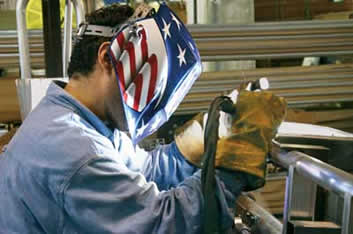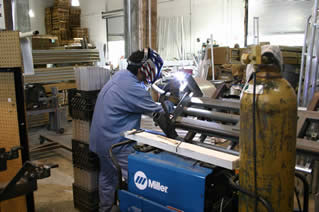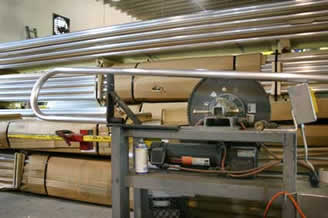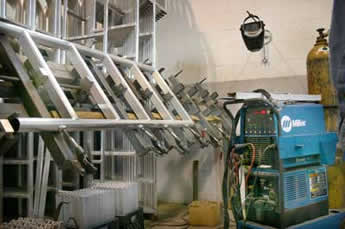Executive Summary
- Eight additional ladders built per day.
-
Less grinding and rework.
-
Adjustable balance and frequency offers better control over bead appearance and profile.
-
Does not require high frequency for AC welding.
Florida Fabricator Retires Conventional TIG Technology, Increases Aluminum Ladder Production by 18 Percent With Dynasty Inverters.
To get a leg-up on the competition, you must raise the bar... or the step. The craftsmanship of aluminum dock ladders from A1A Dock Products, Hollywood, Florida, gives this company a giant step-up on the competition. A1A, a five-person, family-owned business, lays claim to being the number one marine aluminum dock ladder manufacturer in the country. But even in the number one spot, A1A believes in a constant climb toward increasing productivity, lowering costs and improving quality.
With this drive and support from Miller district manager Jon Van Pelt, the company recently upgraded from its two conventional technology AC/DC TIG machines in favor of two Dynasty® 300-amp DX AC/DC TIG inverters from Miller Electric Mfg. Co. A1A has been working closely with Van Pelt for about six years, and Helmut Grundler, president of A1A, appreciates their great relationship, as well as Van Pelt's deep understanding for A1A's equipment needs.
"Jon takes care of us," says Helmut. "If we have a problem, Jon is there to help us. He knows what we need."
Although its "old" TIG machines functioned perfectly, AIA justified the upgrade because of the Dynasty's advanced squarewave technology.
"With the Dynasty, you can weld much more quickly," says Derek Grundler, production manager. "And when you strike an arc, it draws a puddle at least twice as fast as conventional TIG."
Through its inverter technology, the Dynasty increased production by 18 percent, provided a payback time of two weeks per machine and improved weld bead consistency.
|
A1A relies on the Dynasty DX TIGRunner system for producing the best weld bead appearance, as well as increasing productivity and improving quality. With the Dynasty, the fillet weld shown here (between the rung and one side of the ladder) looks the same on every rung of every ladder.
|
|
Small Steps Build Momentum
When Helmut Grundler gets an idea in his head, wheels start to turn, literally. Helmut, son Derek and wife Helen (who is vice president), continue to develop A1A's manufacturing process at an ever-growing pace.
Prior to retirement in 1993, Helmut's career consisted largely of making aircraft tools. After working at Pan Am and Delta Air Lines, Helmut started D&H Precision and continued to make aircraft tools for Boeing until 1997. However, Helen says, "the brains behind the operation" was tired of the cutthroat competition and lower-quality work winning bids. As is often the case with entrepreneurs, timing was everything. When shopping at a marine supply store with a friend, Helmut noticed a ladder on display that was shimmed in an attempt to level what were clearly uneven legs. "What a mess," he commented, so the friend challenged him to make a better ladder. Helmut acquired some aluminum pipe, bent it with an old bender and welded his own ladder.
When he brought the ladder back to the store, the quality of his work sealed the deal. The store would give orders to Helmut as long as he could meet demands and maintain precision. Helmut, wired for precision and quality after a lifetime of meeting aircraft standards, didn't see a problem. Derek, who also possesses exceptional design skills, had a sharp sales and marketing edge, and Helen understood customer relationships. She began calling every dock supply company in Florida and offered them free shipping for taking a look at Helmut's ladders.
"They immediately saw a difference in work quality," says Helen. "They also saw that we bought a premium grade of aluminum. It almost looks like it is anodized."
 |
For eliminating marine growth, simply retract this 5-step lift ladder above the water line. The ladder features a locking guide and patented heavy-duty rung hanger.
|
Helmut and Derek inspected every section of pipe that came into the shop. If a pipe was scratched, they sent it back; this raised shipping standards from the mill. As they began to purchase more aluminum, they realized that they could call the shots, and ultimately they received the highest quality, finished material. A1A currently purchases about 250,000 lbs. of 6063 T5 Marine Grade Aluminum per year.
"Our customers are just so delighted to see their shiny aluminum ladder coming in," says Helen.
With the emphasis on a quality and craftsmanship, A1A exclusively uses the TIG process because it produces the best weld bead appearance. Customers have responded to this quality orientation. Since its foundation in 1998, A1A has expanded its fabrication area from 2,500 to 5,000 to 10,000 sq. ft. The company now manufactures several different ladder styles (3- to 7-step models) for fresh and saltwater applications, as well as custom-built ladders for swim floats and seawalls (visit www.a1adockproducts.com for details).
Two-Week Payback
Despite the Grundlers' do-it-yourself mentality (see side bar story at end of document), they prefer to rely on Miller's Dynasty DX TIGRunner system for welding. This package pairs the compact (106-lbs.) Dynasty with a Coolmate 3 cooling system and a carrying cart/cylinder rack for mobility. According to Derek, the purchase of the Dynasty was just another step up in A1A's manufacturing savvy.
 |
Arturo Miguel easily rotates the welding fixture to weld the ladder rungs to the back of this five-step ladder in the flat position. Notice how he welds at just below eye-level while resting his wrists on the fixture.
|
"It depends on the type of ladder, but we manufacture an average of additional eight ladders per day with the Dynasty as opposed to a conventional TIG welder," says Derek. "The Dynasty inverter bought itself in the first two weeks of operating."
With ladders selling for an average of $85 and A1A's two full-time fabricators producing eight more ladders per day, the company increased sales by approximately $600 per day after switching to the Dynasty. Given that A1A welds six days a week (the fabricators have the option to work Saturday if they want the extra money), the two Dynasty inverters paid for themselves after about 24 days of welding. Fig. 1 shows a more formal payback and ROI calculation based on general accounting principles.
"I didn't want to change in the beginning," says Helmut, who initially did not see the value of a new machine when his old ones still ran well. "Then I found out how much better the Dynasty welded."
To maintain competitiveness, Helmut notes that, "Our ladders cannot cost more than the competition, so I don't want to hire more manpower. But since we have such a demand, I'd rather invest in better machinery to upgrade production and pay our fabricators a little more to keep them happy."
Advanced Squarewave Productivity
Unlike AC welding with conventional TIG machine where the output frequency is fixed at 60 Hz, the Dynasty permits the operator to adjust the output frequency from 20 to 250 Hz and extend the balance control up to 90 percent electrode negative (compared to a maximum of 68 percent for conventional technology). For welding marine ladders, A1A uses a frequency of at least 150 Hz and sets the balance control at 75 percent. This focuses the arc cone in a narrow column, increases penetration at the root of the joint, minimizes the etched zone and removes heat from the tungsten.
"The Dynasty creates a much narrower weld bead than a conventional TIG," notes Derek. "It allows us to direct the arc(which really helps when welding in corners(where conventional machines spread out the arc. The technology also lets us sharpen the tungsten like a pencil point and maintain a point, so the arc comes off of the tip" instead of dancing around a balled tungsten and creating a wide bead
The ability to tailor the weld bead profile, making it only as wide as necessary, eliminates the over-welding that typically occurs with conventional TIG technology in fillet weld applications (a weld bead only needs to be as wide and the thinnest member, or just .060 or .080 in. for A1A's ladders). Eliminating over-welding means that joints require less filler metal and less heat, so travel speeds naturally increase.
Miller engineers estimate that advanced squarewave technology, in a fillet weld application, can improve productivity by up to 20 percent(and A1A experienced an 18 percent increase.<
This technology also improves weld bead appearance. "We only have a 1/8-in. white line (etched zone) around the weld," says Derek. "With conventional TIG, no matter what you do, you're going to get a 1/4-in. white line around the weld."
A1A uses a 3/32-in., 2 percent thoriated tungsten, 3/32-in. diameter 4043 filler wire and an argon/helium shielding mix (25 percent helium to increase penetration, 75 percent argon for arc stability). The welding current averages 100 to 110 amps.
Better Starts, Faster Learning
Because it uses inverter technology, the Dynasty does not require continuous high frequency (HF) for AC welding. To weld aluminum, its "HF start only" mode start the arc in the DC electrode positive mode for a few milliseconds and produces a short burst of high frequency. Once the machine senses the arc has been established, it shuts off the HF to minimize any potential interference with electronic equipment, a problem with conventional machines.
"With the Dynasty, arc starts are perfect," says Helmut. "And we don't have to worry about high frequency, which is a big thing in Florida where we have a lot of moisture."
Outside of the dramatic increase in production, Derek recognizes an equally dramatic step up in the Dynasty's technology compared to conventional technology: ease-of-use.
"The difference between inverter and conventional TIG technology is like night and day," says Derek. "If I were ever to teach anyone how to weld, I would teach them how to weld on the Dynasty."
 |
Miguel works in tight, crowded spaces, so he appreciates the compact, mobile Dynasty DX TIGRunner system.
|
Strict Standards
A1A sets its own standards and sets them high. Equipment is built and used for absolute accuracy and consistency. Materials are measured, cut, bent, fixtured and welded so that each ladder produced is 100 percent the same as the previous-and next-ladder.
"Anybody can buy a pipe and bend it," says Helmut. "But the weld is what makes a quality ladder, and it's quality work we aim for. You can see it. Every weld looks the same. We achieve repeatability because we have the right equipment. Our welds look like they came off a computer. Our old TIG equipment was good, but we could not make 10 weld beads look the same, like they do now."
Helmut uses a simple analogy to explain what's behind A1A's philosophy. "Quality is the bottom line, because that's what people want. When you go to the store and buy a newspaper, you don't take the top newspaper, you pull one from underneath because it looks better. Dock ladders are no different. Quality comes first at A1A, and that's the bottom line."
Miller Economic Evaluation Summary: A1A Dock Products
1. Estimated Annual Savings (present minus proposed costs*) $28,224
2. Welding Investment $14,400
3. Annual Depreciation (Line 2 divided by 5 years) $ 2,880
(assumes straight line depreciation)
4. Annual Savings After Depreciation (Line 1 minus Line 3) $25,344
5. Profit After Taxes (66% of Line 4) $16,727
6. Annual Cash Savings (Line 5 plus Line 3) $19,607
Return on Investment (Line 6 divided by Line 2 X 100) 136 %
Payback Period (Line 2 divided by Line 6 X 12 months) 8.8 months
*By increasing productivity from an average of 25 to 32 ladders per day, A1A lowered labor costs by $3.15 per ladder. Assuming 280 workdays per year: 280 days X 32 ladders X $3.15 labor savings = $28,224.
Do-it-yourself Manufacturing
For building the ladders, A1A uses 1-1/4-in. Schedule 40 pipe (.140 wall thickness) and 1-1/2-in. Schedule 10 pipe (.109 wall thickness). The steps are 1/8-in. thick aluminum. The company has their own dies at the mill. When first extruded, the aluminum is so soft that you can bend it by hand, but the mill then tempers it to the final grade (T5).
The material is shipped to A1A in 20-ft. pieces that are brought in and placed in sections near the cut saw. First, the pipes are measured for the various styles of ladders. They are cut to size, de-burred, placed in bins and moved to the pipe bender. The grooved ladder rungs are punch cut to match the pipe diameters. Where most manufacturers get their materials re-cut from the mill, A1A realizes less waste and higher quality with its cutting process. A CNC machine will soon be installed to further improve consistency.
At the bender, just one of many machines designed and built by Helmut, the pipes are bent to a 14-in. radius, the smallest possible on 1-1/4-in. Schedule 40 pipe before it collapses. A U-channel is placed between the hoop on the right and left sides of the ladder, which is the hung up and ready to be placed in the welding fixture.
|
Helmut uses the pipebender to bend the pipe to a 14-in. radius. Once the U-channel is placed between the hoop on the right and left sides of the ladder, it is hung up and ready for welding.
|
 |
Helmut designed and manufactured the fixture himself to make the welding process fail-safe. Tony Madrigal and Arturo Miguel, experienced welders at A1A, can easily place the ladder sides into the fixture, insert the rungs and clamp the ladder components in place. So that Tony and Arturo can weld in the optimum position, the fixture rotates so that they can flip the ladder over and turn it at varying degrees. They complete all welding in this single fixture.
 |
With this sophisticated welding fixture built by Helmut Grundler, A1A welders easily clamp the dock ladder in place for more precise welding with the Dynasty DX. The "all-in-one" fixture was designed to accommodate three- to seven-step (and custom) ladders.
|
"No one else in the industry has sophisticated fixtures like this," says Derek. "That fixture has really paid for itself over and over again.
"Helmut agrees. "We make a lot of equipment ourselves, because you can't always buy the equipment that will do the best job," says Helmut. "Like the pipe bender, the dies and the welding fixture, you just can't buy them. I come from trades. I'm a toolmaker. I worked all of my life as a toolmaker, and now I make the tools for A1A."